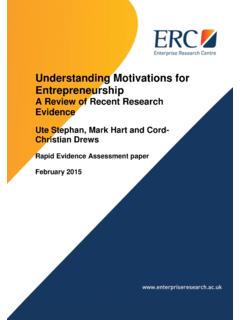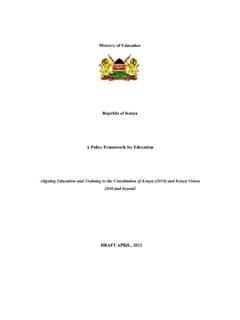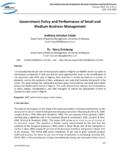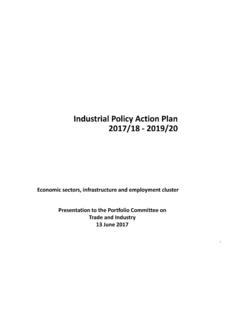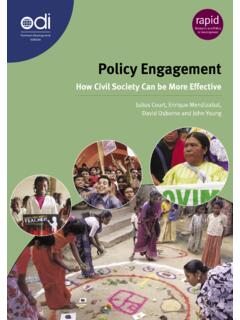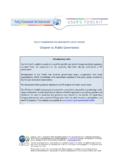Transcription of Cambodia Industrial Development Policy 2015 – 2025
1 UNOFFICIAL TRANSLATION Royal Government of Cambodia Cambodia Industrial Development Policy 2015 2025 Market Orientation and Enabling Environment for Industrial Development Approved by Council of Ministers at Its Plenary Meeting on 06 March 2015 UNOFFICIAL TRANSLATION Table of Contents Executive Summary .. I 1) Introduction .. 1 ) The necessity of the Industrial Development Policy .. 1 ) Main context of the Cambodian Economy .. 3 2) Status of the Industrial sector in Cambodia .. 4 ) Overview of the Industrial Structure .. 4 ) Key challenges of Industrial Development in 8 3) Vision .. 13 4) Objectives and Targets .. 13 5) Strategic Framework .. 15 ) Key Strategies for Industrial Development .. 15 ) Scope and Priority Sectors .. 16 ) Approach of Implementation .. 18 6) Policy measures and action plans .. 19 ) Investment Promotion .. 19 ) Expansion and Modernization of SMEs.
2 21 ) Improvement of Regulatory Environment .. 23 ) Coordination of Supporting Policies .. 26 7) Mechanism for Policy Leadership, Coordination and Implementation .. 31 ) Strengthening the Role of the Council for the Development of Cambodia .. 32 ) Revising Functions and Strengthen the Capacity of CIB .. 32 ) Streamlining Functions of CRDB .. 33 ) Strengthening the Consultation Mechanism with the Private Sector .. 34 ) Establishing Monitoring and Evaluation of Policy Implementation .. 34 8) Management of Major Risks .. 35 9) Conclusion .. 36 UNOFFICIAL TRANSLATION -I- Executive Summary 1. Driven by its long-term vision toward 2030, particularly as expressed in the Rectangular Strategy Phase III , the Royal Government of Cambodia (RGC) has prepared and adopted this Industrial Development Policy as a guide to promote the country's Industrial Development that will help maintain sustainable and inclusive high economic growth through economic diversification, strengthening competitiveness and promoting productivity.
3 2. The launching of this Policy connotes the necessity and the urgency to embark on a new growth strategy that responds to the structural transformation of domestic economy and the changing regional and global economic architecture. The adoption of this Policy is motivated by the following considerations: First, the favorable geopolitical spillovers in terms of linking Cambodian economy and its industry to the region especially within the ASEAN Economic Community and regional economic liberalization frameworks; Second, the potential role of Industrial sector in promoting growth and creating new jobs in the context of an open economy, a demographic dividend and major structural changes that are conducive for Industrial growth; Third, the critical role of Industrial sector as a Policy tool to enhance the performance of core economic sectors, like agriculture and services, that will further contribute to boosting economic growth.
4 And Fourth, the importance of the Industrial sector as a focus for initiating both structural reforms and governance reforms of key national economic institutions with the aim at boosting economic productivity in long term and avoiding falling into the middle income trap . 3. Cambodia s Industrial sector remains weak and narrow based as reflected by its simple structure of manufacturing and low level of sophistication that mainly concentrates on garments and food processing, while most manufacturing activities are still family-based and do not have the capacity to compete in the international market. Key features of Cambodian industries consist of a lack of diversity in Industrial base; an informal and missing middle structure; a weak entrepreneurship, an urban-centered industry, a low value addition and low level of technology application.
5 Micro-enterprises which make up over 97% provide only a mere 30% of job creation and generate only a 12% of the total turnover. Large enterprises which make up only of create, on the other hand, some 63% of jobs and generate some 76% turnover. Moreover, the number of informal enterprises is extremely excessive. Entrepreneurship remains weak and urban-centered, with over 42% of enterprises were just established since 2008. More than 63% of large manufacturing enterprises are in the form of foreign direct investment and export-oriented. 68% of large manufacturing enterprises are located in Phnom Penh and 13% in Kandal province. 4. The Development of Cambodia s Industrial sector is confronted with five key obstacles: First, the lack of leadership, coordination and effective decision-making especially on all important issues especially related to the inadequate supply of electricity, infrastructure and logistics, human UNOFFICIAL TRANSLATION -II- resource and skills as well as other supporting infrastructures; Second, the scarcity of basic technical knowledge and skills that is crucial to transform an unskilled labor-force into a skilled labor force capable of absorbing new and high value technical and technological skills.
6 Third, inadequate preparation of the necessary Industrial infrastructure, especially as related to insufficient coordination in physical infrastructure investment such as supply of electricity, clean water, telecommunication network, sewage and public service provision; Fourth, limited financial market Development that hinders the financing of Industrial projects and lack of financing mechanism for public and private sector projects; and Fifth, issues related to the labor market and Industrial relations that is key to labor market stability with adequate supply of labor, increase in productivity and better livelihood for the workers. 5. The RGC s vision is to transform and modernize Cambodia s Industrial structure from a labor-intensive industry to a skill-driven industry by 2025, through connecting to regional and global value chain; integrating into regional production networks and developing interconnected production clusters along with efforts to strengthen competitiveness and enhance productivity of domestic industries; and moving toward developing a technology-driven and knowledge-based modern industry.
7 The realization of this vision will contribute to national economic Development , sustainable and inclusive high economic growth, employment creation, increased valued added to the economy and increased income for the Cambodian people. 6. To realize the vision of IDP, the RGC has set three targets: First, to increase the GDP share of Industrial sector to 30% by 2025 ( of GDP in 2013) with the manufacturing sector growing from in 2013 to 20% in 2025; Second, to diversify the export of goods by increasing the export of non-textile to reach 15% of all exports by 2025 while still promoting the export of processed agricultural products to reach 12% of all exports by 2025; and Third, to encourage the formal registration of 80% of small enterprises and 95% of medium enterprises and to ensure that 50% of small enterprises and 70% medium enterprises to have proper accounts and balance sheets.
8 7. In order to realize the said vision and the targets set above, the RGC has embraced four strategies: First, mobilizing and attracting foreign investments as well as private domestic investments by focusing on large industries, expanding markets and enhancing more technology transfer; Second, developing and modernizing small and medium enterprises (SMEs) (expanding and strengthening the manufacturing base, modernizing the registration of enterprises, ensuring technology transfer and Industrial linkages); Third, revisiting the regulatory environment so as to strengthen the country competitiveness (investment climate and trade facilitation, market information dissemination and informal fees reduction); and Fourth, coordinating supporting policies ( Development of human resource, technical training, improvement of Industrial relations, Development of support infrastructure such as transportation/logistics and information and communication system (ICT), supply of electricity and clean water, and public, social and financial services.)
9 UNOFFICIAL TRANSLATION -III- 8. The strategic approach of the IDP is to promote the Development of the manufacturing sector and agro-processing industry through integration into regional and global production chain; positioning the Development of Industrial zones so as to ensure critical mass, economic linkages and competitiveness; Development of economic corridors, streamlining the operational procedures for Special Economic Zones (SEZs) and developing new Industrial parks and Industrial clusters. The scope and key priorities include: First, new industries or manufacturing that can break into markets, providing high value-added, innovative and highly competitive; Second, promoting SMEs across all sectors; Third, increasing agricultural production to serve both export and domestic markets; Fourth, encouraging various support industries for the agricultural, tourism and garment sectors in as much as for industries that form part of the global production value chain; and Fifth, support industries that support regional production chain and those which are strategic for nurturing future industries.
10 9. With this strategic approach, the Royal Government has instituted comprehensive and interconnected Policy measures and action plans with well-defined responsible institutions to lead the implementation process (see in details Annex D). These Policy measures and action plans altogether encompass the following: First, actively promote FDI focusing on improving the investment climate, Development of SEZs and preparation of Industrial zones; Second, strengthen and modernize SMEs focusing on their formalization and the provisions of incentives, encourage proper bookkeeping and accounting practices, and promoting the agro- Industrial sector; Third, improving regulatory environment focusing on trade facilitation measures and export promotion, strengthening Industrial standards and Industrial property rights, facilitation of payment of tax obligations, establishment of a labor market and Industrial relations.

